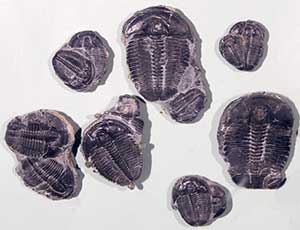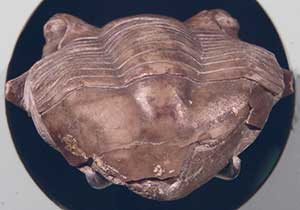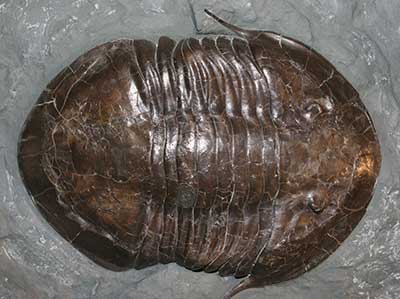Trilobite
| Linnaean Classification | |
|---|---|
| Kingdom: | Animalia |
| Phylum: | Arthropoda |
| Class: | Trilobita |
| Photos | |
 | |
| Elrathia kingi | |
 | |
| Illaenus tauricornis | |
 |
| Isotelus brachicephalus |
History
The Trilobites made their first appearance in the early Cambrian period around 526 million years ago. However, evolutionary evidence suggests that they may have existed before the Cambrian period. Their origin is unknown as they do not appear to share evolutionary traits with other Arthropods, they may have evolved as a whole without too many evolutionary interactions with other Arthropods. As the Paleozoic era progressed they gradually died off becoming extinct. All but one species died out in the Devonian period, and then the Trilobites completely disappeared in the mass-extinction that marked the end of the Paleozoic era. Due to their large number, diversity, and hard exoskeletons, Trilobites fossilized very well. Over 20,000 species have currently been documented. Due to the mystery of their origin and their diversity it is not entirely clear how to classify them. They have been found worldwide, and new species have been discovered yearly. The largest trilobite Istelus rex was found in 1998 in Canada. Today the closest modern relative of the Trilobite is the Horseshoe Crab.Description
Although the different species of Trilobites differentiate in some aspects, all Trilobites generally have similar characteristics. They had a large head and head shield. Most of their body was formed from three lobes. They had a large Axial Lobe, acting as a sort of spine running through the middle of their body. On each side of the Axial Lobe was a Pleural lobe of various sizes and configurations. Some rare discoveries of about 21 species have provided some rare soft tissue elements of the body, including legs, gills, digestive tracts, and eyes. Their size was diverse ranging from 1 millimeter to 72 centimeters. Some fossils show the Trilobite rolled in a ball. Some Trilobites evolved to have large spikes protruding from its lobes. This was more common during the Ordovician until the Devonian. Other Trilobites would have horns like modern beetles. A large proportion of Trilobites had antennae, and some had other appendages used for clawing at food or prey. Many Trilobites had complex eyes, ranging from a nearly 360 degree view to being completely blind, possibly for living in the deep sea.Lifestyle
There have been several proposed lifestyles for the different species of Trilobite including sea-bed predators, preying on worms or other such prey, scavengers, or swimming plankton eaters. The horns on top of the heads of some Trilobites may have been used for competition and is the earliest known documentation of a species with that behavior. They probably reproduced sexually with eggs, even though this theory could possibly be in error because only one sample of eggs have been found that could belong to Trilobites. Trilobites would start as larvae and then would slowly grow and produce an exoskeleton. With time they would molt their exoskeleton by splitting components of their heads and crawling out through it. They would then wait some time for a new exoskeleton to fully form.
ScienceViews Writer: Jason Hamilton.
Copyright © 2005-2010 Calvin & Rosanna Hamilton. All rights reserved.